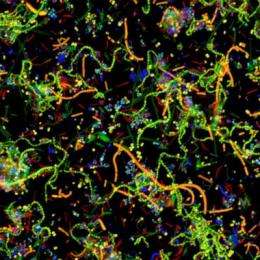Choosing your neighbors: Scientists see how microbes relate in space

Like people in cities, microbes often live in complex communities that contain many different microbial types. Also like us, microbes tend to gravitate to and "hang out" with certain other types in their community, more than with the rest. And sometimes, when opportunities arise, they move to more favorable locations.
But until recently, scientists have not been able to look at a microbial community and distinguish the spatial relationship of more than 2 or 3 kinds of microbes at once.
Now, a microscopy technique developed at the Marine Biological Laboratory (MBL), allows scientists to see the spatial arrangement of up to 28 differently labeled microbes in a single field of view.
"We get information on the presence of many different microbes at once and get it quickly, cheaply, and perhaps more accurately than other methods," says Gary Borisy, president and director of the MBL and co-author of a paper describing the technique published today in Proceedings of the National Academy of Sciences.
"Just as you may move to a certain neighborhood because the schools are good for your kids, the neighborhood is important for microbes," Borisy says. "When we find out where (in a community) they like to hang out, that has implications for how they function."
The new technique, called CLASI-FISH (combinatorial labeling and spectral imaging fluorescent in situ hybridization), is faster than traditional ways of identifying the microbes in a sample (by laboratory culture or by DNA sequencing). Plus, it reveals the spatial structure of the community, which these methods do not.
"We don't just find out who is there. We find out where they are in space," Borisy says.
Borisy and his colleagues, including Floyd Dewhirst of the Harvard School of Dental Medicine, used the technique to analyze dental plaque, a complex biofilm that is known to contain at least 600 species of microbes. They were able to visually discriminate 15 different microbial types, and to determine which 2 types (Prevotella and Actinomyces) showed the most interspecies associations.
"That might imply some functional interaction between them," Borisy says. "One may be facilitating the other to colonize the site, and the exchange will reap some benefit for them both."
The lead author on the paper is Alex M. Valm, a student in the Brown-MBL Graduate Program in Biological and Environmental Sciences. Another team member, MBL scientist Jessica Mark Welch, is leading the effort to apply CLASI-FISH to the organization of microbial communities in another setting—the guts of mice harboring defined populations of human microbes.
"It's very possible that this technology will enable a new kind of clinical diagnostic procedure, so that it will be possible to very quickly and accurately diagnose a specimen for many kinds of microbes at once," Borisy says. "As an alternative to culturing, it could be faster, cheaper, and better."
More information: Valm, A.M., Mark Welch, J.L., Rieken, C.W., Hasegawa, Y., Sogin, M.L., Oldenbourg, R., Dewhirst, F.E., and Borisy, G.G. (2011) Systems-level analysis of microbial community organization through combinatorial labeling and spectral imaging. PNAS Early Edition (Feb. 14), doi/10.1073/pnas.1101134108
Provided by Marine Biological Laboratory















